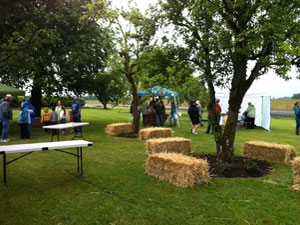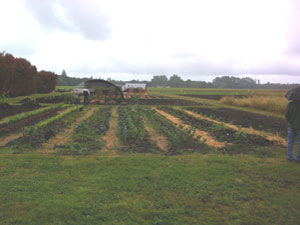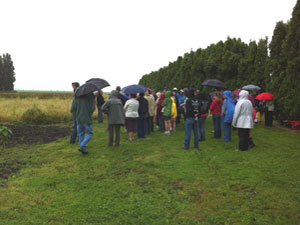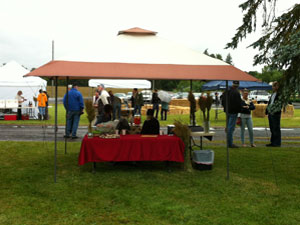

Home | Spaceship Earth | Book Reviews | Buy a Book | Bean and Grain Index | Short Stories | Contact | Mud Blog
Weather in the Willamette Valley is not particularly predictable, but the last four growing seasons have been remarkably similar. Spring has been cool and wet. May has shown the promise of summer with two or three weeks of sun and moderate temperatures, but June always seems to break that promise with more rain than we want and too many days where the temperature seems stuck below 60 degrees. July is the month when summer begins. The weather suddenly becomes dry as dirt and bright and sunny as a new dime, but this only lasts into the first or second week of September when the morning dew gets heavy, the probability of rain enters the forecast, and grains and beans better be out of the field.
This year followed that pattern. June 30, 2012 was not a pretty day in western Oregon. It was cool and heavily clouded. Light rain came and went throughout the day. In Tangent where the land stretches out flat in all directions and grass seed production has long been king, the gray clouds and intermittent rain were a reminder to the visitors arriving at Stalford Seed Farms that the weather does what it wants, and more than anything else that is the farmers' burden to bear.
Billed as a "Locavore's Delight" the fourth annual Stalford Seed Farm Tour really was. We talk about fresh vegetables and organic fruit. We visit the farm stands looking for tomatoes and melons, but the real foundation of our diet is beans and grains. There's no being a locavore if local farmers aren't growing a variety of grains and legumes–because you can't make a sandwich between two leaves of lettuce. The folks at Stalford Seed Farms as much as any farm in the Willamette Valley are responsible for jump starting the Bean and Grain Project.
Gian Mercurio, Willow Coberly's mother, was the tour guide and she opened the afternoon by introducing the Stalford Seed Farms' family, starting with Willow and her husband Harry Stalford, their children, Mary Ann Jasper, Gian's sister, four young farmers who work at the farm, two exchange students from Italy, and some of the others who help make the 6,000-acre Stalford Seed Farms successful.
Harry MacCormack attended the tour. He was introduced after the family and staff. Harry spoke emphatically about his concern about GMO crops in the valley, the invasive danger they pose to organic growers, even a fear that there might one day be GMO wheat in western Oregon. Should that happen, any hope of rebuilding a local agricultural economy based on organic wheat, easily the most important grain we can grow here, will be dispersed like pollen in the wind.


With a steady mist falling, Gian led the group of visitors around the back of the farm buildings to the employee garden. This quarter acre plot produces fresh vegetables for the employees to eat at lunch or take home. It gives the workers a place to spend time during work breaks, and it also serves as a place for the farm to experiment with organic techniques and bean varieties.
Gian walked the group south from the employee garden. With her son-in-law Harry Stalford holding an umbrella for her, she talked about the crops the farm was growing, why they were growing them, how they were growing them, and even how they sold them–a process she called inside-out marketing–that is, selling locally first, regionally second, and globally third.
From that original 12-acre plot of transitional hard red wheat in 2007, Stalford Seed Farms now boasts 500 acres of organic farmland. Along with their 5500 acres of conventional crops, soft white wheat, clover, and seed producing grasses, the organic portion of the farm is growing black beans, garbanzo beans, barley, malting barley, emmer–an ancient grain from Egypt, spelt, oats, dry peas, rye, flax, and triticale.


Overall, Stalford Seed Farm is progressing step by step to their goal of a sustainable farm. They make their own compost and compost tea. They have gradually sophisticated their crop rotation with legumes for nitrogen fixing, buckwheat as a phosphate pump, and a varieties of cover crops for nitrogen and/or organic matter. The fields include beehives and beetle banks for beneficial insects. They maintain the riparian zone along the creeks that flow through their property, and they have more organic ground for food crops every year. This is definitely not your father's grass seed operation.
Stalford Seed Farms has expanded its business model beyond mere production by adding processing capacity. Greenwillow Grains is their small grain mill in Brownsville. Willamette Seed and Grain, their distribution arm, offers seed cleaning, grain milling, and oat rolling services to local farmers and sells whole wheat bread flour, wheat berries, rolled oats, oat flour, flax seed, and garbanzo beans. This is the new model for large farms—sustainable production and on-farm processing.
________________
As always, feedback to this webpage is welcome. If you attended either of the tours, feel free to offer corrections or additions. In the end, the Bean and Grain Project meetings, farm tours, and these articles are meant as forums about growing beans, grains, and edible seeds in the Willamette Valley. Discussion and the sharing of ideas are themes central to the project. Click to email.
Special thanks is extended to The Willamette Farm and Food Coalition and The Ten Rivers Food Web, Hummingbird Wholesale and the Evergreen Hill Fund of Oregon Community Foundation for their continued support of the Southern Willamette Valley Bean and Grain Project.